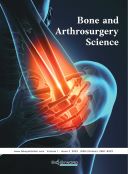Abstract
Objective: This paper aims to observe and explore the application effect of unilateral double-channel endoscopic lamina fenestration decompression in the clinical treatment of patients with lumbar spinal stenosis. Methods: The study period is from January 2020 to December 2022, 60 patients with lumbar spinal stenosis were recruited and divided into the control group (traditional interlaminar fenestration) and the study group (unilateral double-channel endoscopic lamina fenestration decompression) according to the method of coin tossing, with 30 cases in each group. The operation time, perioperative blood loss, incision diameter, total hospitalization time, postoperative complications, Japanese Orthopedic Association (JOA), Numerical Rating Scale (NRS) pain score, and excellent rate of lumbar recovery were compared. Results: The operation time of the study group was longer than that of the control group, the amount of perioperative blood loss was lower than that of the control group, the incision diameter was smaller than that of the control group, and the total hospitalization time was shorter than that of the control group (P < 0.05). Postoperative complications such as dural tear, cerebrospinal fluid leakage, infection, and paravertebral muscle injury in the study group were less than those in the control group (P < 0.05). The JOA score of the study group was higher than that of the control group, and the NRS score was lower than that of the control group 6 months after operation (P < 0.05). The operation effect was evaluated according to the modified MacNab standard 6 months after operation, and the excellent rate of lumbar spine recovery in the study group was higher than that in the control group (P < 0.05). Conclusion: Unilateral double-channel endoscopic fenestration decompression of the lamina has a definite application effect, it can significantly reduce postoperative complications of lumbar spinal stenosis, and promote the recovery of lumbar spine function. It has the advantages of mild pain, high safety, less bleeding, small incision, and other advantages, which can be recommended in the treatment of lumbar spinal stenosis.
References
Dong W, Chen Q, 2019, Analysis of Population Characteristics of Lumbar Degenerative Diseases Among Ethnic Minorities in Dali Area. Hainan Medicine, 30(05): 569–571.
Xu S, Zhang J, Xing J, et al., 2022, Comparison of the Short-Term Efficacy of Unilateral Dual-Channel Endoscopy and Transforaminal Endoscopy in the Treatment of Lumbar Spinal Stenosis. Chinese Journal of Minimally Invasive Surgery, 22(09): 712–716.
Lu H, Hu P, Tian L, et al., 2022, Comparison of Unilateral and Bilateral Decompression Under Unilateral Dual-Channel Endoscopy for Lumbar Spinal Stenosis. Chinese Journal of Orthopedic Surgery, 30(18): 1643–1647.
Sun B, Che X, 2012, Evaluation and Treatment of Japanese Orthopedic Association (JOA score). Chinese Journal of Neurosurgery, 28(06): 623–623.
Li C, Zhang W, Fan B, 2016, Comparison of Numerical Scale (NRS) and Verbal Scale (VRS) in Elderly Patients with Chronic Pain. Chinese Journal of Pain Medicine, 2016(09): 683–686.
Su B, Luan S, Sun L, et al., 2022, Unilateral Dual-Channel Endoscopic Treatment of Double-Segment Lumbar Spinal Stenosis. Chinese Journal of Orthopedic Surgery, 30(16): 1508–1511.
Huang Y, Luo S, Liang G, 2019, A Meta-Analysis of the Clinical Efficacy of Simple Decompression and Decompression Fusion in the Treatment of Lumbar Spinal Stenosis. Journal of Guangxi Medical University, 36(06): 929–934.
Fan L, Ma Y, Luo Y, et al., 2022, Research Progress of Unilateral Dual-Channel Spinal Endoscopy in the Treatment of Lumbar Spinal Stenosis. Chinese Journal of Orthopedics and Traumatology, 30(09): 82–88.
Jiang C, Huang Y, Zuo H, et al., 2022, Early Clinical Efficacy of Unilateral Dual-Channel Endoscopic Lumbar Fusion and Minimally Invasive Transforaminal Lumbar Fusion in the Treatment of Single-Segment Lumbar Spinal Stenosis with Instability. Chinese Academy of Medical Sciences, 44(04): 563–569.
Ma M, Ma Z, Wang Y, et al., 2022, Single-Axis Endoscopic Decompression - Double-Channel Endoscopic Visual Lumbar Fusion in the Treatment of Lumbar Spinal Stenosis Combined with Lumbar Instability. Chinese Journal of Bone and Joint Injuries, 37(07): 686–690.
Hu Q, Xie S, Sun L, et al., 2022, Clinical Efficacy Analysis of Unilateral Dual-Channel Endoscopy in the Treatment of Lumbar Spinal Stenosis. Journal of Practical Orthopedics, 28(06): 533–536.
Chen T, Cheng Z, Zhang C, 2022, Application Progress and Thinking of Unilateral Dual-Channel Spinal Endoscopy in the Treatment of Lumbar Spinal Stenosis. Massage and Rehabilitation Medicine, 13(11): 70–73.
Pan Y, Shi C, Sun H, 2022, Clinical Efficacy and Long-Term Safety Evaluation of Different Surgical Methods for the Treatment of Degenerative Lumbar Scoliosis and Lumbar Spinal Stenosis. Chinese Journal of Gerontology, 42(09): 2147–2150.
Chen T, Wang Q, Zhang C, et al., 2021, Observation on the Curative Effect of Spinal Canal Decompression Under Unilateral Dual-Channel Endoscopic Technique in the Treatment of Lumbar Spinal Stenosis. Chinese Journal of Bone and Joint Injuries, 36(09): 905–908.
Tuo W, Zhou L, Liu D, et al., 2021, A Preliminary Study on the Treatment of Lumbar Spinal Stenosis with Unilateral Dual-Channel Endoscopy. Chinese Journal of Minimally Invasive Surgery, 21(01): 56–60.
